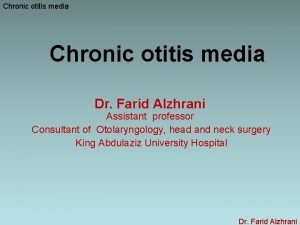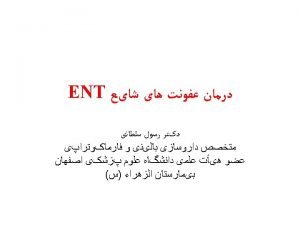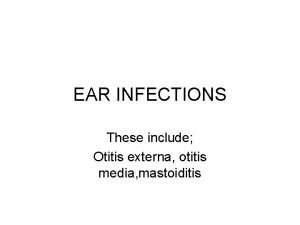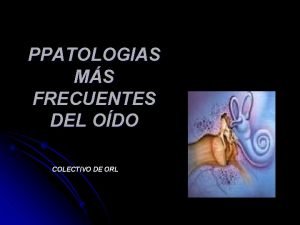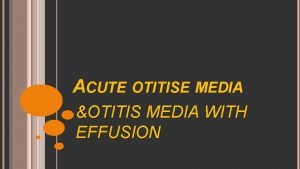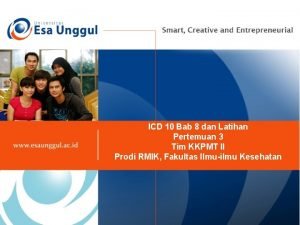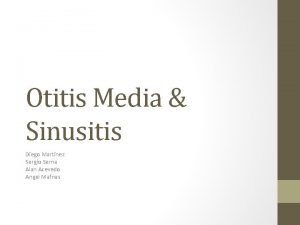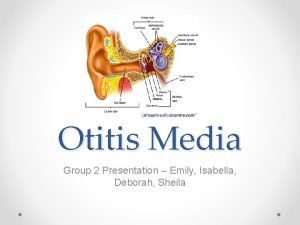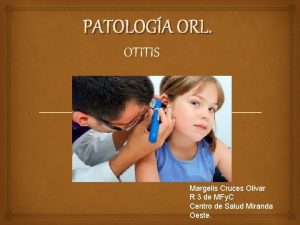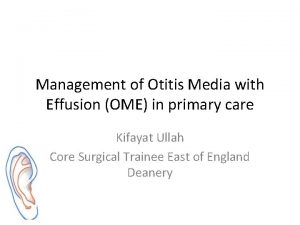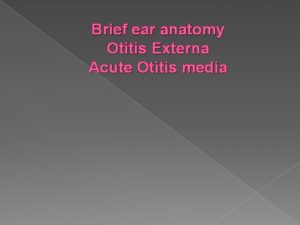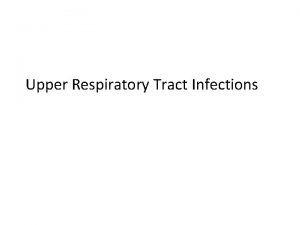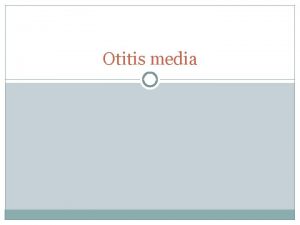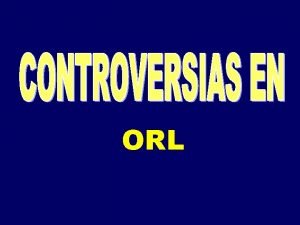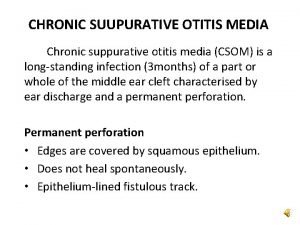Acute Otitis Media Acute Otitis Media Acute otitis










- Slides: 10

Acute Otitis Media

Acute Otitis Media Acute otitis media, i. e. acute inflammation of the middle-ear cavity, is a common condition and is frequently bilateral. It occurs most commonly in children and it is important that it is managed with care to prevent subsequent complications. It most commonly follows an acute upper respiratory tract infection and may be viral or bacterial. Unless the ear discharges pus from which an organism is cultured it is impossible to decide one way or the other.

PATHOLOGY Acute otitis media is an infection of the mucous membrane of the whole of the middle-ear cleft— Eustachian tube, tympanic cavity, attic, aditus, mastoid antrum and air cells. The bacteria responsible for acute otitis media are: Streptococcus pneumoniae 35%, Haemophilus influenzae 25%, Moraxella catarrhalis 15%. Group A streptococci and Staphylococcus aureus may also be responsible. The sequence of events in acute otitis media is as follows: 1 organisms invade the mucous membrane causing inflammation, oedema, exudate and later, pus; 2 oedema closes the Eustachian tube, preventing aeration and drainage; 3 pressure from the pus rises, causing the drum to bulge; 4 necrosis of the tympanic membrane results in perforation; 5 the ear continues to drain until the infection resolves.


SYMPTOMS Earache may be slight in a mild case, but more usually it is throbbing and severe. The child may cry and scream inconsolably until the ear perforates, the pain is relieved and peace is restored. Deafness is always present in acute otitis media. It is conductive in nature and may be accompanied by tinnitus. In an adult, the deafness or tinnitus may be the first complaint. SIGNS Pyrexia The child is flushed and ill. The temperature may be as high as 40°C. Tenderness There is usually some tenderness to pressure on the mastoid antrum.

The tympanic membrane varies in appearance according to the stage of the infection. 1 Loss of lustre and break-up of the light reflex. 2 Injection of the small vessels around the periphery and along the handle of the malleus. 3 Redness and fullness of the drum; the malleus handle becomes more vertical. 4 Bulging, with loss of landmarks. Purple colour. Outer layer may desquamate, causing blood-stained serous discharge. Early necrosis may be recognized, heralding imminent perforation. 5 Perforation with otorrhoea, which will often be blood-stained. Profuse and mucoid at first, later becoming thick and yellow.

Mucoid discharge from an ear must mean that there is a perforation of the tympanic membrane. There are no mucous glands in the external canal. TREATMENT The treatment depends on the stage reached by the infection. The following stages may be considered: early, bulging and discharging. Early Antibiotics Penicillin remains the drug of choice in most cases, and ideally should be given initially by injection followed by oral medication. In children under 5 years, when Haemophilus influenzae is likely to be present, amoxycillin will be more effective, and should always be considered if there is not a rapid response to penicillin. Coamoxiclav is useful in Moraxella infections. Be guided by sensitivity reports from the laboratory.

Analgesics Simple analgesics, such as aspirin or paracetamol, should suffice. Avoid the use of aspirin in children because of the risk of Reye’s syndrome. Nasal vasoconstrictors The role of 0. 5% ephedrine nasal drops is traditional but its value is uncertain in the presence of acute inflammation of the middle ear. Ear drops are of no value in acute otitis media with an intact drum. Especially illogical is the use of drops containing local anaesthetics, which can have no effect on the middle-ear mucosa yet may cause a sensitivity reaction in the meatal skin. Bulging Myringotomy is necessary when bulging of the tympanic membrane persists, despite adequate antibiotic therapy. It should be carried out under general anaesthesia in theatre and a large incision in the membrane should be made to allow the ear to drain. Pus should be sent for bacteriological assessment. Following myringotomy, the ear will discharge and the outer meatus should be dry-mopped regularly.

Analgesics Simple analgesics, such as aspirin or paracetamol, should suffice. Avoid the use of aspirin in children because of the risk of Reye’s syndrome. Nasal vasoconstrictors The role of 0. 5% ephedrine nasal drops is traditional but its value is uncertain in the presence of acute inflammation of the middle ear. Ear drops are of no value in acute otitis media with an intact drum. Especially illogical is the use of drops containing local anaesthetics, which can have no effect on the middle-ear mucosa yet may cause a sensitivity reaction in the meatal skin. Bulging Myringotomy is necessary when bulging of the tympanic membrane persists, despite adequate antibiotic therapy. It should be carried out under general anaesthesia in theatre and a large incision in the membrane should be made to allow the ear to drain. Pus should be sent for bacteriological assessment. Following myringotomy, the ear will discharge and the outer meatus should be dry-mopped regularly.

Discharging—nature’s myringotomy If the ear is already discharging when the patient is first seen, a swab should be sent for culture of the organism. Antibiotic therapy should be started but modified if necessary when the result of the sensitivities is known. Regular aural toilet will be necessary. FURTHER MANAGEMENT Do not consider acute otitis media to be cured until the hearing and the appearance of the membrane have returned to normal. Acute Otitis Media 37 If resolution does not occur, suspect: 1 the nose, sinuses or nasopharynx? Infection may be present; 2 the choice or dose of antibiotic; 3 low-grade infection in the mastoid cells. RECURRENT ACUTE OTITIS MEDIA (AOM) Some children are susceptible to repeated attacks of AOM. There may be an underlying immunological deficit such as Ig. A deficiency or hypogammaglobulinaemia that will need to be investigated. Long-term treatment with half-dose cotrimoxazole may be beneficial. If the attacks persist, grommet insertion may prevent further attacks but may result in purulent discharge.
